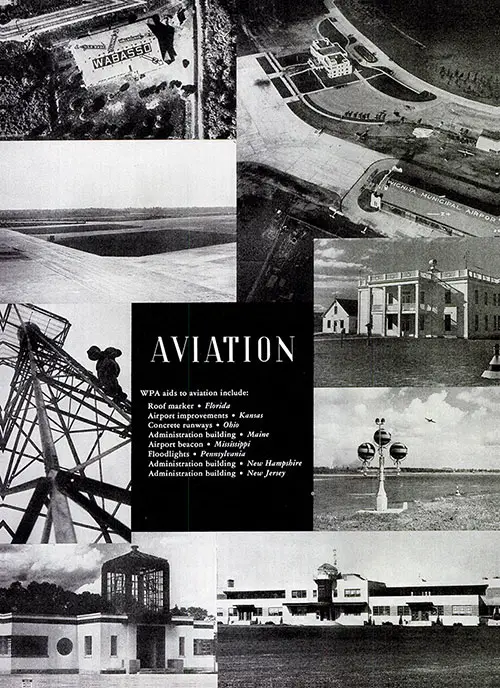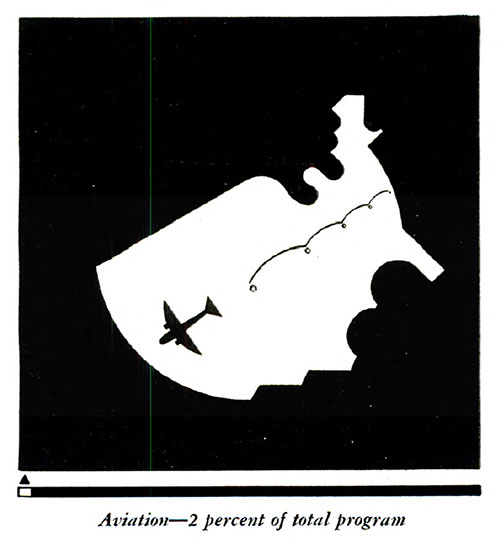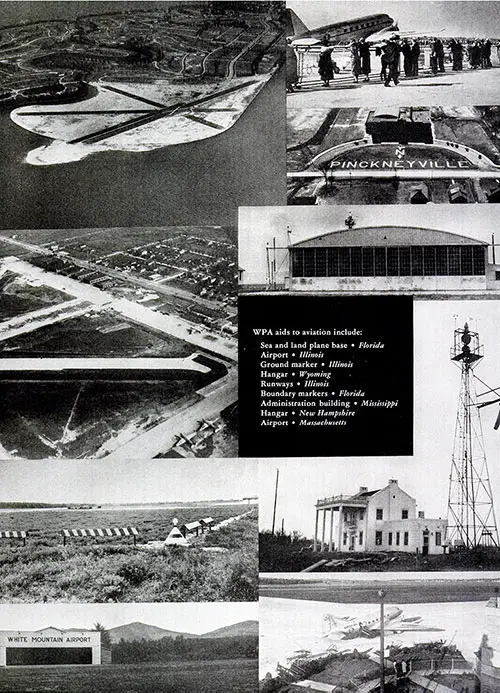WPA Aviation Projects - 1938

WPA Aids to Aviation Include: Roof Marker (Florida), Airport Improvements (Kansas), Concrete Runways (Ohio), Administration Building (Maine), Airport Beacon (Mississippi), Floodlights (Pennsylvania), Administration Building (New Hampshire), Administration Building (New Jersey). Inventory: An Appraisal of Results of the Works Progress Administration, Washington, DC: US Government Printing Office, 1938. GGA Image ID # 151f3af27e
The WPA's completed work on 266 landing fields has aided American municipalities in their desperate struggle to keep ground facilities abreast of the phenomenal growth in the size and speed of transport airplanes.

Aviation—2 Percent of Total Program. Inventory: An Appraisal of Results of the Works Progress Administration, Washington, DC: US Government Printing Office, 1938. GGA Image ID # 151f7eb8f3
WPA workers have constructed 130 new landing fields and improved 136 others, embracing a total area of nearly 34,000 acres. They have constructed new runways totaling more than 200 miles in length and repaired or improved an additional 72 miles. These runways range from 50 to 350 feet in width.
They have built 73 new hangars and completed improvements on 75 others, as shown under the section on Public Buildings, as well as constructed several score administration buildings and other lesser airport structures. The new and improved hangars are capable of housing more than 1,900 aircraft.
They have installed lighting facilities on 276 airports, athletic fields, or other outdoor areas requiring high illumination, and erected 36 air beacons of both the visual and radio beam type. To assist aviators in getting their bearings while in flight, WPA workers have painted or constructed 8,357 air markers—large signs on the roofs of buildings or on the ground which can be read from the air, giving the location of the marker and of the nearest airport.
Federally paid WPA manpower from the relief rolls was made available to local communities at a time when American municipalities in many cases had found themselves unable to continue their airport development because of reduced tax revenue. Hundreds of them were able, however, to provide local funds for materials and equipment, and these applied for airport projects.
Locations and general plans were passed upon for technical flaws by the Bureau of Air Commerce, while counsel on the general program was given by the War and Navy Departments concerning national defense, as well as by the Post Office Department concerning air mail routes.
WPA airport improvements range from major facilities for several score of the Nation's largest terminals to simple clearing and leveling of emergency landing fields in hazardous flying areas.
Examples of its major improvements include construction of the bituminous landing mat at Cleveland airport, the largest single piece of paving in the world; construction of the administration building and huge public hangar at Newark, the Nation's busiest terminal; and extensive improvement to Boiling Field, important Army post in Washington, D. C.
There is scarcely an airport on the country's entire airline system which has not been improved in some respect by the WPA. In Chicago and San Francisco, in Salt Lake City, Fort Worth, and Boston, in St. Louis and Detroit, in Kansas City and New Orleans, Charleston and Akron, Pittsburgh and Washington—on literally hundreds of American airports, these workers who couldn't find private jobs have built a wide variety of needed facilities.
Under the sponsorship of the city of New York, they are building the great new terminal at North Beach, on Flushing Bay, adjacent to the World's Fair grounds. Such projects provide a high proportion of labor for unskilled manual workers in large- scale grading and drainage operations, while skilled workers such as engineers and draftsmen also are needed.
Of this airport and airway program, the late Major General O. Westover, Chief of the Army Air Corps, said on July 7, 1937: "You are apparently making excellent progress, and everywhere I go I have heard the most favor- able comment upon the progressive work being accomplished."
W. H. Gannett, Maine publisher and flying enthusiast, said, "I don't know of any development work undertaken by the Federal administration that is more important or of greater lasting benefit to the general public."
Harry W. Colmery, National Commander of the American Legion in July 1937, called the program "a basic contribution to the national defense."
Gill Robb Wilson, President of the National Association of State Aviation Officials, following a Nation-wide tour of these projects, said in his annual report on December 2, 1937: "From either the standpoint of original construction or improvement on already existing airports, the majority of those WPA projects which we visited and inspected represent a full decade of normal growth of aviation ground facilities. Both air commerce and national defense owe a debt of sincere gratitude to the Works Progress Administration."

WPA Aids to Aviation Include: Sea and Land Plane Base (Florida), Airport (Illinois), Ground Marker (Illinois), Hangar (Wyoming), Runways (Illinois), Boundary Markers (Florida), Administration Building (Mississippi), Hangar (New Hampshire), Airport (Massachusetts). Inventory: An Appraisal of Results of the Works Progress Administration, Washington, DC: US Government Printing Office, 1938. GGA Image ID # 151f61e4fe
ADDENDA
While airport work of a somewhat heavier type has been carried out under the WPA than under the CWA and FERA, the earlier programs operated projects on more than 1,200 landing fields of all classes. The three programs, taken together, have built 750 new fields and made needed improvements on nearly 750 others.
"Aviation," in Inventory: An Appraisal of Results of the Works Progress Administration, Washington, DC: US Government Printing Office, 1938, pp. 29-32.

